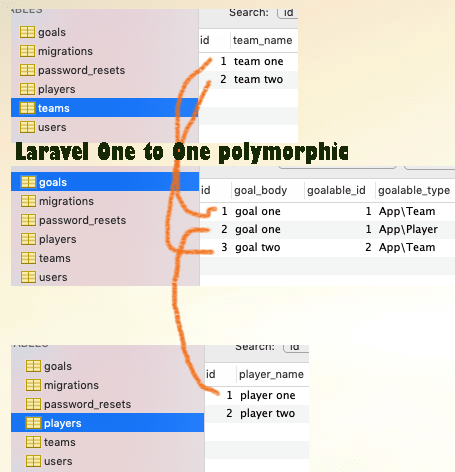

- Laravel eloquent find 1 to many relationship how to#
- Laravel eloquent find 1 to many relationship software#
This is the key on the pivot table which identifies the relationship to the project. Finally, we select the related foreign key. The third parameter is the key on the pivot table that holds the key of the model we are relating. So, we use our pivot table which is users_projects. The second parameter is the table the relationship takes place on.

The first parameter is the model you are relating to. When setting up many-to-many relationships with Eloquent, there are 4 parameters you need to set. First, let’s open our User model and add the projects relationship: belongsToMany('App\Models\Project', 'users_projects', 'user_id', 'project_id') With Eloquent you have to use the belongsToMany() relationship on both the User and the Project. Defining our Relationshipsīefore we move into all of the methods regarding many-to-many relationships, we have to define the relationship on each of our models. Now that we have our tables constructed, let’s define our relationships in the App\Models\User.php and App\Models\Project.php Eloquent models respectively. This way we can only directly set this value if needed and don’t accidentally create users with admin permissions. When creating the table, I always set the default permission column to be member.
Laravel eloquent find 1 to many relationship how to#
I’ll document how to update this value efficiently. In future references, this table is also referred to as the pivot table.įor now, the values of the permission column could either be admin or member. Notice the permission column on the users_projects table? That column will determine the level of access the user has on a project. Our projects table should look like: projectsĪnd our users_projects table should look like: users_projects For simplicity sake, I won’t be adding EVERY field, just enough to make sure this tutorial makes sense.Īt the most basic level, our users table should look like: users The tables will be users, projects, and users_projects. Let’s set this up.įirst we will create 3 tables within our Laravel Install.

These will be stored in the pivot table along with the relationship with the project. On each project and organization, the user has permissions. For this example, every user can belong to multiple projects and multiple organizations. That’s managing user permissions on projects and organizations. Set up a Many-To-Many Relationship with Laravel Eloquentįor this example, we are going to use a real life situation we came across when building Bugflow. I’ve tended to use a lot of these to set up Gates & Policies and other permission structures in Laravel. However, I was always slightly confused when creating and updating related data so I wrote this tutorial as a guide for myself and for you. There are a lot of other basic and useful methods available for defining and querying these relationships. In this tutorial we’ll go through a few of my favorite methods when updating and creating many-to-many relationships with Laravel Eloquent. When I had to write raw SQL, I always hated many-to-many relationships. Eloquent has so many powerful features making working with a database so enjoyable! One of my favorite features of Laravel Eloquent is the many-to-many relationship structure. Laravel provides the most beautiful Object Relational Mapping systems I’ve ever used with Eloquent.
Laravel eloquent find 1 to many relationship software#
If you want to search with multiple columns then you have to extend this macro to support multiple columns.Build better software and get user feedback directly in GitHub, GitLab, and more. The following example represents, how to use it: public function index() Example 3: Laravel whereLike with multiple columns using macros You can use the LIKE MySQL keyword and % wildcard character with the where clause. Example 1: Laravel where Like Query use with Eloquent Model In laravel, using whereLike() eloquent method, you can implement laravel where like search query, laravel where like multiple columns and laravel collection with where like. You can use the LIKE MySQL keyword and % wildcard character with where clause. The LIKE a query is used in a WHERE clause to search for a specified pattern in a column. When you put the search form in your application, you need to use like query to get matched pattern.


 0 kommentar(er)
0 kommentar(er)
